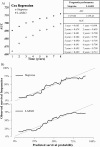Developing and Validating an Individualized Clinical Prediction Model to Forecast Psychotic Recurrence in Acute and Transient Psychotic Disorders: Electronic Health Record Cohort Study
- PMID: 34172999
- PMCID: PMC8530399
- DOI: 10.1093/schbul/sbab070
Developing and Validating an Individualized Clinical Prediction Model to Forecast Psychotic Recurrence in Acute and Transient Psychotic Disorders: Electronic Health Record Cohort Study
Abstract
Acute and transient psychotic disorders (ATPDs) include short-lived psychotic episodes with a high probability of developing psychotic recurrences. Clinical care for ATPD is currently limited by the inability to predict outcomes. Real-world electronic health record (EHR)-based retrospective cohort study STROBE/RECORD compliant included all individuals accessing the South London and Maudsley NHS Trust between 2006 and 2017 and receiving a first diagnosis of ATPD (F23, ICD-10). After imputing missing data, stepwise and LASSO Cox regression methods employing a priori predictors (n = 23) were compared to develop and internally validate an individualized risk prediction model to forecast the risk of psychotic recurrences following TRIPOD guidelines. The primary outcome was prognostic accuracy (area under the curve [AUC]). 3018 ATPD individuals were included (average age = 33.75 years, 52.7% females). Over follow-up (average 1042 ± 1011 days, up to 8 years) there were 1160 psychotic recurrences (events). Stepwise (n = 12 predictors) and LASSO (n = 17 predictors) regression methods yielded comparable prognostic accuracy, with an events per variable ratio >100 for both models. Both models showed an internally validated adequate prognostic accuracy from 4 years follow-up (AUC 0.70 for both models) and good calibration. A refined model was adapted in view of the new ICD-11 criteria on 307 subjects with polymorphic ATPD, showing fair prognostic accuracy at 4 years (AUC: stepwise 0.68; LASSO 0.70). This study presents the first clinically based prediction model internally validated to adequately predict long-term psychotic recurrence in individuals with ATPD. The model can be automatable in EHRs, supporting further external validations and refinements to improve its prognostic accuracy.
Keywords: brief psychotic disorder; clinical prediction modeling; individualized prediction acute and transient psychotic disorder; psychosis; schizophrenia; validation.
© The Author(s) 2021. Published by Oxford University Press on behalf of the Maryland Psychiatric Research Center. All rights reserved. For permissions, please email: journals.permissions@oup.com.
Figures



Similar articles
-
Long term outcomes of acute and transient psychotic disorders: The missed opportunity of preventive interventions.Eur Psychiatry. 2018 Aug;52:126-133. doi: 10.1016/j.eurpsy.2018.05.004. Epub 2018 May 19. Eur Psychiatry. 2018. PMID: 29787962
-
Dynamic ElecTronic hEalth reCord deTection (DETECT) of individuals at risk of a first episode of psychosis: a case-control development and validation study.Lancet Digit Health. 2020 May;2(5):e229-e239. doi: 10.1016/S2589-7500(20)30024-8. Epub 2020 Mar 26. Lancet Digit Health. 2020. PMID: 33328055
-
First-episode acute and transient psychotic disorder in Latvia: a 6-year follow-up study.Nord J Psychiatry. 2014 Jan;68(1):24-9. doi: 10.3109/08039488.2012.761726. Epub 2013 Feb 5. Nord J Psychiatry. 2014. PMID: 23383651
-
Clinical outcomes in brief psychotic episodes: a systematic review and meta-analysis.Epidemiol Psychiatr Sci. 2021 Nov 4;30:e71. doi: 10.1017/S2045796021000548. Epidemiol Psychiatr Sci. 2021. PMID: 35698876 Free PMC article.
-
Acute and transient psychotic disorders (ICD-10 F23): a review from a European perspective.Eur Arch Psychiatry Clin Neurosci. 2009 Dec;259(8):433-43. doi: 10.1007/s00406-009-0008-2. Epub 2009 Apr 21. Eur Arch Psychiatry Clin Neurosci. 2009. PMID: 19381705 Review.
Cited by
-
Physical Health in Clinical High Risk for Psychosis Individuals: A Cross-Sectional Study.Brain Sci. 2023 Jan 12;13(1):128. doi: 10.3390/brainsci13010128. Brain Sci. 2023. PMID: 36672109 Free PMC article.
-
Mapping the implementation and challenges of clinical services for psychosis prevention in England.Front Psychiatry. 2023 Jan 3;13:945505. doi: 10.3389/fpsyt.2022.945505. eCollection 2022. Front Psychiatry. 2023. PMID: 36660464 Free PMC article.
-
Physical Health and Transition to Psychosis in People at Clinical High Risk.Biomedicines. 2024 Feb 26;12(3):523. doi: 10.3390/biomedicines12030523. Biomedicines. 2024. PMID: 38540135 Free PMC article.
-
Timing of antipsychotics and benzodiazepine initiation during a first episode of psychosis impacts clinical outcomes: Electronic health record cohort study.Front Psychiatry. 2022 Sep 23;13:976035. doi: 10.3389/fpsyt.2022.976035. eCollection 2022. Front Psychiatry. 2022. PMID: 36213895 Free PMC article.
-
Development and validation of a prediction model for rehospitalization among people with schizophrenia discharged from acute inpatient care.Front Psychiatry. 2023 Aug 24;14:1242918. doi: 10.3389/fpsyt.2023.1242918. eCollection 2023. Front Psychiatry. 2023. PMID: 37692317 Free PMC article.
References
-
- Castagnini AC, Fusar-Poli P. Diagnostic validity of ICD-10 acute and transient psychotic disorders and DSM-5 brief psychotic disorder. Eur Psychiatry. 2017;45:104–113. - PubMed
-
- Fusar-Poli P, de Pablo GS, Correll CU, et al. . Prevention of psychosis: advances in detection, prognosis, and intervention. JAMA Psychiatry. 2020;77(7):755–765. - PubMed
-
- Catalan A, Salazar de Pablo G, Vaquerizo Serrano J, et al. . Annual Research Review: Prevention of psychosis in adolescents—systematic review and meta‐analysis of advances in detection, prognosis and intervention. J Child Psychol Psychiatry. 2020;2(5):657–673. - PubMed
Publication types
MeSH terms
Grants and funding
LinkOut - more resources
Full Text Sources
Medical

